|













|
|
The first owner of SENTA, Dr. Cees den Hartoog,
published this article in the February 1976 issue of Yachting World
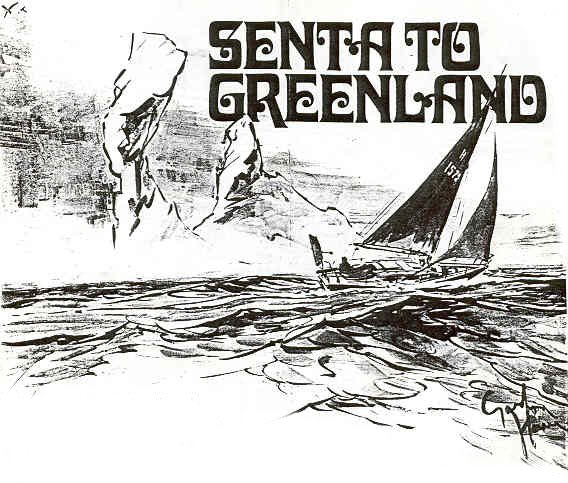 Singlehanded
sailing high latitudes must be the most demanding sort of cruising. Dr. C. den
Hartoog finds the challenge irresistible. Singlehanded
sailing high latitudes must be the most demanding sort of cruising. Dr. C. den
Hartoog finds the challenge irresistible.
Why should a hardworking general practitioner spend the whole of his precious
holidays on tiring voyages to distant destinations? I don't know, dear friends,
but my wife believes that most modern males are, from nature's viewpoint, having
such miserable lives that the craving for corporal and spiritual challenges at
last becomes irresistible and then a good, long sailing voyage is a very fitting
solution. Maybe she is right: at any rate it simply makes you happy to do it and
afterwards offers the same satisfaction as a long skating trip in heavy weather,
climbing difficult trees or swimming in surf in a strong onshore breeze.
To become a reasonable sailor it is not quite sufficient to cross the
North Sea or to make a summer voyage to the Baltic. Now and then you should
choose a difficult passage, with small crews, and accept the setbacks of such a
voyage as a necessary training and education. With these considerations in mind
the intention to sail to Greenland was born. Don't suspect me of
masochism, all my close friends know better.
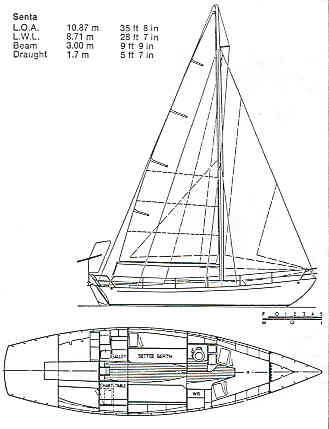 In
our newly (1970) completed transom-sterned aluminium sloop (length 10.87 m, beam
3.00 m, draught 1.70 m, my wife and I made, in the same year, a very
pleasant voyage to the Azores and back, and on the way praised the designer
Dick Koopmans, the builder Wolter Huisman, and the sailmaker Ubbe de Vries. In
our former yacht, a steel double ender of 28 ft, we had already visited all West
European coasts. However, the idea to sail to the Arctic did not fall on good
ground with my faithful mate. Especially when I told her honestly that during
the outward voyage strong and often stormy head- winds were to be expected, that
beyond Cape Farewell during 40 per cent of the time fog could be met and that it
would be necessary to acquire the fine art of ice navigation. She quite rightly
concluded that this would be a bit too much for a grandmother. I had to sail alone.
Not cosy, but very instructive. In
our newly (1970) completed transom-sterned aluminium sloop (length 10.87 m, beam
3.00 m, draught 1.70 m, my wife and I made, in the same year, a very
pleasant voyage to the Azores and back, and on the way praised the designer
Dick Koopmans, the builder Wolter Huisman, and the sailmaker Ubbe de Vries. In
our former yacht, a steel double ender of 28 ft, we had already visited all West
European coasts. However, the idea to sail to the Arctic did not fall on good
ground with my faithful mate. Especially when I told her honestly that during
the outward voyage strong and often stormy head- winds were to be expected, that
beyond Cape Farewell during 40 per cent of the time fog could be met and that it
would be necessary to acquire the fine art of ice navigation. She quite rightly
concluded that this would be a bit too much for a grandmother. I had to sail alone.
Not cosy, but very instructive.
That year, 1971, I first called at Reykjavik, where I was happy
enough to meet Major Tilman, a most inspiring man. I was told by experienced ice
pilots that at that moment all harbours of East Greenland were beset by heavy
pack, and for a ship like mine would be only accessible after 4 to 6 weeks. That
was too long for me to wait, so with a heavy heart I sailed back by way of
Scotland, where I took my wife on board. Next year I was better informed. North
of Frederickshab, on the west coast of Greenland, during summer, it is usually
possible to circumnavigate the pack. You have only to deal with bergs, which can
be avoided one by one. The general course from Holland is NW. 500 miles to the
60th parallel, after that 1300 miles west to Cape Farewell and finally 200 or
300 miles NW. to Frederickshab.
On
the 10th of June. 1972, at the Naval Yacht Harbour of Den Helder, I said goodbye
to my wife, my eldest son and my youngest granddaughter, and driven by a fine
sou'westerly breeze Senta quickly brought the dunes of Texel below the horizon.
No need to steer, Hasler's Trimtab Vane Steering kept her nicely on her course.
In the afternoon we passed some of the drilling platforms, that nowadays
disfigure the North Sea. For the rest attention had to be paid to the numerous
trawlers, cutters and drifters on the Doggerbank, Silverpit and Fladengrounds,
names that brought back memories of my youth when I was sent to the herring
fisheries for educational reasons. The wind was free: during the last few days I
could set a trade wind rig. Senta runs beautifully under this rig, but as soon
as the sea begins to rise she rolls rather heavily.
After four days Fair Isle came in sight after which the course became
west, right into the wind. On the North Atlantic Ocean the direction of the
prevailing winds is between WSW. and WNW., so for a passage to Greenland a
yachtsman has to reckon with a tacking course of about 1500 miles. Senta is very
close winded: even in Force 8 she still easily wins height, too easily I think
sometimes, for under those circumstances the onrushing seas can deal such heavy
blows that at some places the plating betwee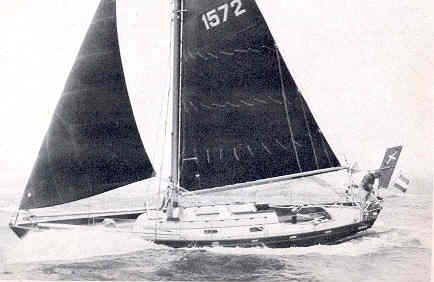 n the frames becomes dented, as I
found out already during the voyage to Iceland last year. Yet making west must
be the first and foremost object in the mind of the Greenland sailor. He must in
this respect be a bit of a monomaniac, otherwise he simply won't arrive there. n the frames becomes dented, as I
found out already during the voyage to Iceland last year. Yet making west must
be the first and foremost object in the mind of the Greenland sailor. He must in
this respect be a bit of a monomaniac, otherwise he simply won't arrive there.
Two days after Fair Isle everything pointed to an approaching gale,
falling glass, low and heavy skies, backing and rising wind. I can just take a
bath on deck with seawater and detergent, but then Senta needs her storm
staysail and treble reef. A gale at sea in a good ship is not as bad as some
stories try to tell you. There are only two worries: will everything remain
intact and is there enough room downwind? Room a-lee is no problem on the ocean
and Senta is a well-built ship, so when all necessary measures are taken there
is no reason for worry and the only thing to do is to wait watchfully until the
weather improves. The sight of the ocean in a gale is a sublime spectacle. It
frees the human spirit from lower matters and lifts the soul to higher planes.
This first gale meant no problem, but alas, after a slight improvement
the Shipping Forecast warned for a new and very deep depression with westerly
winds of Force 10. When this promise was fulfilled we were 200 miles north of
Rockall. All sail is handed, and Senta, her helm lashed a-lee rides the enormous
seas with the wind a little forward of the beam. Every 10 minutes the steering
well is flooded by the overcoming water, but to my great joy and relief the ship
herself throws most of it out again with the next sea. Like a living creature
Senta struggles, rearing and rolling over the breaking crests, rising against
every on- storming sea and diving deeply into the following valley. When all
work on deck was done and I was looking at this awe inspiring scene, both hands
secured around the lee lower shrouds, we were thrown completely flat by a
particularly heavy breaker. The ship lay on her port side, her mast in the sea.
Her skipper went under water and was pushed outboard along the shrouds by the
roaring sea. After some seconds Senta recovered and swung me aboard again with
an enormous sweep. At that moment I felt myself considerably less at home on the
ocean than I thought before. For some days the muscles of my lower arms were
stiff and sore, but I was lucky enough to be able to tell you this story. It
would have been safer to run, but in this gale that would have meant an hourly
loss of 5 or 6 hard-earned miles. Twenty hours later a small sail could be set
again and the battle for making west resumed. In the weeks to follow a long
procession of lows, several with gale force wind travelled from west to east. In
the centre of such depressions it was sometimes almost calm, but it never paid
to un reef. It was gradually getting considerably colder, 5° C down below and
still colder on deck. The loneliness and lack of human contact were dull, but it
caused no significant spiritual decay as far as I could perceive myself.
However, when on a certain Sunday I heard an Eskimo minister launch a preach
over the Greenland Radio system, I liked the sound of it, although the only
words I understood were Jesus Christ and Amen.
On the 5th of July I sighted the sharp and icy peaks of Greenland in the
neighbourhood of Cape Farewell, on the starboard bow at a distance of about 50
miles. Through Radio Christansund I could transmit a radio telegram for home
that all was well and started to look out for bergs. Alas, in Davis Strait I met
strong northerly winds, so more tacking ahead, but, apart from periods of hail
and rain there was a reasonable visibility, and so when after a few days
numerous icebergs appeared, no difficult situations arose. A big iceberg makes a
very deep impression on the insignificant man. The enormous mass of ice, in its
irresistible course is a symbol of silent, but relentless might, capable of
careless destruction, but at the same time a spectacle of unearthly beauty in
countless shades of light blue and soft, green hues. I circumnavigated them all
at a safe distance, for the thundering surf on their weathersides inspired deep
awe.
On the latitude of Frederickshab I asked the local radio station whether
the coast was bound by pack. A very helpful radio officer inquired at the
coastguard and called me again after half an hour, telling me there was no pack
of any significance, only bergs, so that calling at Frederickshab would not be
very difficult. Not that difficult perhaps, but in front of the coast of
Greenland are countless archipelagoes of small rocky islands, many of them just
below the surface at high water. Moreover, icebergs often obstruct the view of
important marks ashore. But all went well and on 12 July, after 31 days of
almost continual tacking I could moor Senta alongside a small wooden cutter,
assisted by four Greenland girls, who apparently had nothing else to do at this
time of the night (2 am). After having expressed my thanks for the pleasant help
at the radio station I tried to sleep, but I did not succeed; everything was
much too quiet.
In the morning a Danish engineer came on board, a very nice gentleman who
had a prompt solution for all domestic problems, like having a sauna and the
handling of the ship's laundry. He invited me for lunch, and seated at his table
in a very comfortable prefabricated Norwegian bungalow I could hear over the
Greenland radio quite a story about Senta's voyage, apparently already passed on
by my host to the news agency.
Frederickshab, with its 2000 inhabitants, is one of the two big
settlements of Greenland. It can only be reached by sea or helicopter if the
weather permits. It has a small hospital, and the doctor who runs it, together
with his wife, showed me over the place and told me about his principal worries:
gonorrhoea, alcoholism and tuberculosis. The local Greenlanders are of mixed
Eskimo-Scandinavian blood. As far as they work they are fishing and hunting, but
there is not enough employment for the rapidly expanding population. The Danish
Government tries to meet this by founding fish-processing industries, while the
local doctor extensively promotes birth control.
Nature around Frederickshab is grand and relentless, the mountains are
steep and barren, with everywhere snow in the shaded places. The village is very
picturesque with its wooden houses in blue and red colours, but just as
everywhere plastic and other rubbish begins to spoil the landscape.
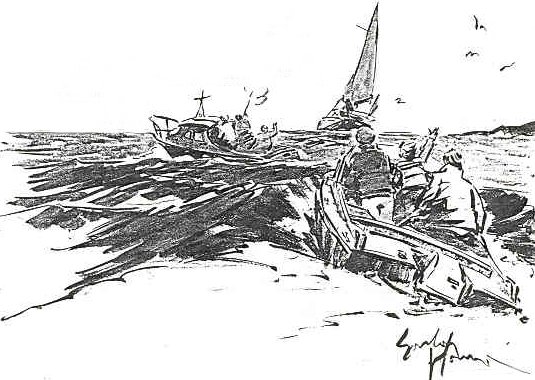 After
four days in Frederickshab I started looking more and more to the mouth of the
fjord, and when a telegram arrived from Holland saying that all was well at
home. I saw no reason to postpone the homeward voyage. Some sporting Danes gave
me a grand send off and when the sea between the skerries became a bit too much
for their little motor launches, fired their rifles as a farewell, while Senta
again put her stem in the icy swell.At first many icebergs required constant
watch, but 50 miles outside the sea was practically ice free. Next day in the
afternoon we met a brief gale which made me very seasick during a few hours, but
after that everything went very smoothly. A running wind at Cape Farewell and
then a fine south-easterly breeze was maintained by a high (very rare in these
seas) that travelled east just in front of me. After a fortnight of excellent
sailing, mostly under full sail, sometimes making more than 170 miles a day, the
first Scottish trawlers were sighted. To my regret on the North Sea visibility
became worse and worse and the last two days before Granton Harbour, where my
wife should come on board, were sailed in dense fog and little wind. During the
last hours extra attention was needed for the numerous ships waiting for the end
of the harbour strikes, at anchor on the Firth of Forth. The vane cannot be
trusted under these circumstances, so the ship had to be steered. On the night
of 30 July the good vessel could be moored to the wooden jetty of Granton
Harbour. After
four days in Frederickshab I started looking more and more to the mouth of the
fjord, and when a telegram arrived from Holland saying that all was well at
home. I saw no reason to postpone the homeward voyage. Some sporting Danes gave
me a grand send off and when the sea between the skerries became a bit too much
for their little motor launches, fired their rifles as a farewell, while Senta
again put her stem in the icy swell.At first many icebergs required constant
watch, but 50 miles outside the sea was practically ice free. Next day in the
afternoon we met a brief gale which made me very seasick during a few hours, but
after that everything went very smoothly. A running wind at Cape Farewell and
then a fine south-easterly breeze was maintained by a high (very rare in these
seas) that travelled east just in front of me. After a fortnight of excellent
sailing, mostly under full sail, sometimes making more than 170 miles a day, the
first Scottish trawlers were sighted. To my regret on the North Sea visibility
became worse and worse and the last two days before Granton Harbour, where my
wife should come on board, were sailed in dense fog and little wind. During the
last hours extra attention was needed for the numerous ships waiting for the end
of the harbour strikes, at anchor on the Firth of Forth. The vane cannot be
trusted under these circumstances, so the ship had to be steered. On the night
of 30 July the good vessel could be moored to the wooden jetty of Granton
Harbour.
After
some hours sleep I was awakened by footsteps on deck. Must be the immigration
officer, I thought, a small man, no doubt, his steps are very light. But to my
great joy my good wife came down the companionway. She arrived the day before
and stayed at the house of Barry Crowther, one of the members of the hospitable
Royal Forth Yacht Cub, an institution of which we both already had very happy
memories. We spent three fine days in Granton Harbour and on 4 August went to
sea again for the last part of the voyage, 400 miles to Den Helder, which took
about three and a half days of happy sailing.
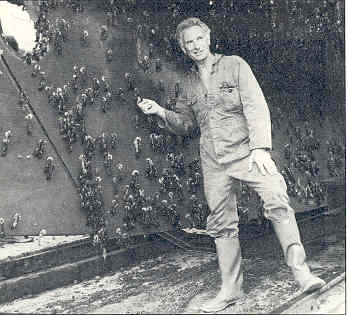 Severe
conditions make great demands of the body, physically and mentally. Dr. den
Hartoog outlines some of the lessons he has learnt. Severe
conditions make great demands of the body, physically and mentally. Dr. den
Hartoog outlines some of the lessons he has learnt.
Fatigue at sea is or a great part a psychological and spiritual weariness.
The typical muscular exhaustion, as experienced after a long run or a long-
distance cycling or skating trip, with the accompanying rise of lactic acid in
the tissues, rarely occurs at sea, but long periods of fog or a few days of gale
puts a heavy strain on our central nervous system and our senses, particularly
on eyesight, hearing and vestibular apparatus, which are battered by an enormous
excess of incoming impulses.
Although generally speaking youth and an excellent physical condition are an
advantage, yet experience and stamina are of predominant importance. That is why
in my opinion long voyages in unfavourable climates, single handed or with small
crews offer the best training for the necessary endurance.
To recondition the nervous system after a difficult spell, sleep is of
paramount importance. Usually a long sleep is out of the question. A quick nap
is better than nothing at all, but if circumstances allow you, a good farmer's
night will make you a new man.
As for drugs, I myself never use any, neither to induce sleep nor to stay
awake. The harmful side effects of drugs, especially those of the stimulants,
never outweigh the benefit of them, which is moreover of very short duration and
always followed by substantial depressions that can be very unwelcome.
Food under tiring circumstances should be light and not abundant. Your blood
is needed in your brain and not in your digestive tract. Small meals of sweets
and biscuits and hot broth or tea will do, with an occasional apple to clean the
mouth. Heavier stuff like fried bacon and eggs should be reserved for after the
crisis.
Fatigue is more difficult to endure when you are wet and cold; wetness and
cold mean an extra burden. Choosing the right foul weather gear means greater
power of endurance.
Finally, I would like to mention one of the most important, maybe the
principal factor to stand up against fatigue, namely peace of mind. Peace of
mind is acquired by skilful fitting out, by knowing your trade, by confidence in
your crew and in your own capacities, even by a happy marriage at home and last
but not least by considering yourself as a privileged person when called upon to
surmount difficult and trying circumstances at sea. Every devoted sailor who has
fought his faithful ship through a really bad gale in a seamanlike way will know
what I mean.
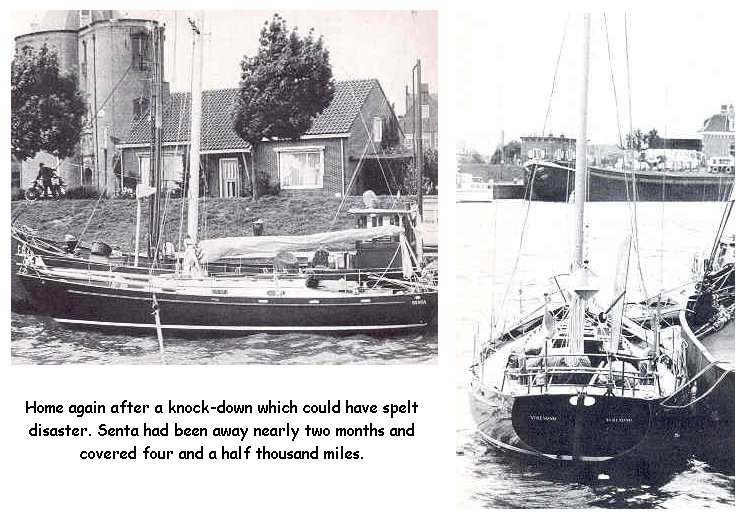

|
